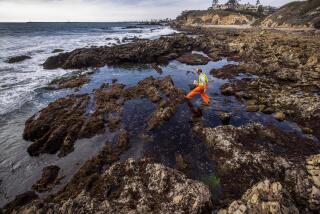Four Years Later, Safety First in North Sea
PLATFORM VIKING B, North Sea — When the alarm screeches, Ashley Brooks heads for the 11-ton orange lifeboat perched at an angle over the side of this North Sea gas platform.
Every person working on the rig, from secretary to driller to baker, knows what to do in an emergency. Some race for the lockers and don firefighting suits. Others walk to the banks of life jackets for the 89 men and one woman who live and work on the platform 80 miles off Lincolnshire.
Brooks is designated as helmsman of one of the two Norwegian-built lifeboats. “You couldn’t have a fatty for helmsman,” said the bearded, slender mechanic, whose post is a tight-fitting chair.
Four years after 167 North Sea oil workers were killed in the world’s worst offshore platform disaster, safety drills are taken seriously. Some rig workers complain that they can hardly do their jobs for all the regulations.
“The bureaucracy is totally taking over,” said Bill Skitt, the rig boss, who has spent 19 years on Viking B. “It’s ridiculous. The safety aspect is becoming extreme. It becomes too over-the-top, so that we can’t work anymore.”
Yet Roger Bibbings, an official of the Trades Union Congress, told a conference on North Sea safety that there was an “enormous amount of apathy among safety representatives” in the industry.
On July 6, 1988, an explosion in the main gas compressor ripped through the Piper Alpha drilling platform, rupturing pipelines and setting off a series of explosions and fires.
The automatic water-deluge system had been turned off to protect divers searching for a possible oil leak from being sucked into intake valves.
Within minutes, the rig was a raging fireball, providing no shelter for the 229 men aboard. The 62 who survived did so by jumping into the flaming, churning sea.
“Piper Alpha was a really major shake up,” said Malcolm Speven, a sociologist with the University of Aberdeen’s Offshore Study Group. “There were a lot of people who’d been wanting to get action done on safety, and finally the doors were open.”
Speven’s organization is conducting a survey of offshore safety for the government’s Health and Safety Executive.
John Cullen, the Scottish High Court judge who investigated Piper Alpha, found that Occidental Petroleum Corp. permitted unsafe practices and that government inspections were “superficial to the point of being of little use.”
Cullen’s report, released in November, 1990, is still being implemented. The Health and Safety Executive has begun consultations with offshore operators on safety proposals, including evacuation and dealing with fire.
Christopher Ryan, director of external affairs for the U.K. Offshore Operators Assn., said the industry will spend more than $2.6 billion putting Cullen’s 106 recommendations into effect. They include new design concepts, better escape and rescue routes, and a more integrated approach to safety.
After the Piper Alpha disaster, Conoco redesigned Viking B, building a box-like living platform separated by a 215-foot bridge from the operating area.
“In the old days, the men lived on one of the other three platforms,” said Gordon Casely, Conoco spokesman. “If the worst came to the catastrophic worst . . . given the most horrific conditions, the accommodation unit would serve as a temporary safe refuge,” for one hour.
From Viking B, all that can be seen are half a dozen “Christmas trees,” the towers of unmanned satellite rigs.
“Nine times out of 10, it’s blowing a hoolie out there with high winds and seas,” said Phil Metcalfe, chief of safety. “We’ve had an 86-foot wave, so you’re going from one hazardous environment to another. The men need to have a safe refuge.”
Viking B’s drill slides through 80 feet of water, which shows little life beyond a few orange jellyfish, and grinds through 10 feet of seabed before it reaches the gas.
Up on the platform, the gas is mixed with chemicals to keep it flowing smoothly then compressed and sent by pipeline to a terminal on shore.
Safety precautions seem pervasive, beginning when a visitor or worker boards one of the large red helicopters that connect the rig to land.
Bulky orange survival suits are worn, with hoods pulled up and zipped high, when the aircraft takes off or lands. Men in firefighting gear stand by.
“There’s always a certain buzz when the alarm goes off,” said Katrina Sleight, a secretary who works two weeks on and two off, like many other members of the Viking B crew.
“I am always consciously aware of the safety aspect,” said Sleight, the only woman on the rig. “You have to keep your eyes open all the time, and if you see someone doing something that could be hazardous, you pull them up.” Keith Newrick, 47, a rigger who installs valves, said the attention to safety is good, but “certain aspects have gone overboard.”
“You don’t need someone to tell us to wear gloves,” he said.
More to Read
Sign up for Essential California
The most important California stories and recommendations in your inbox every morning.
You may occasionally receive promotional content from the Los Angeles Times.









